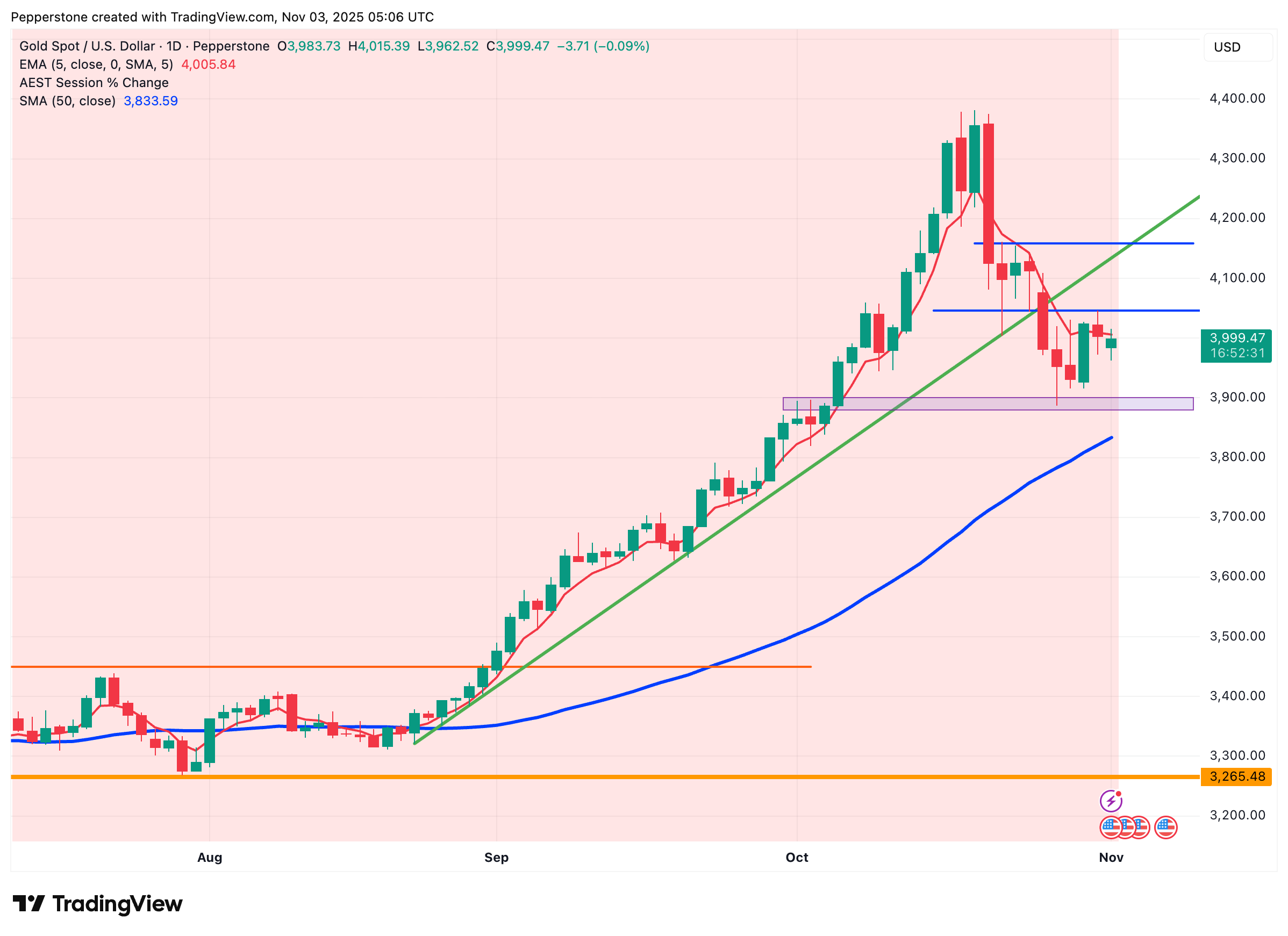- English
- عربي
Over the past week, gold prices have softened amid choppy trading. The easing in U.S.–China tensions, China’s removal of VAT deductions on gold sales, and growing divisions within the Fed over rate expectations have collectively dampened short-term bullish momentum.
Heading into this week, traders are turning their focus to the upcoming U.S. ISM services PMI and several “unofficial” labor market reports, which could inject fresh volatility into gold’s price action.
Technical Observation: Short-Term Pressure Persists, Watch the $4,000 Level
On the daily chart, XAUUSD extended its pullback last week, briefly dipping to $3,886 on Tuesday — its lowest level since October 6. Although technical buying and long-term allocation demand helped gold recover to around $3,900 and close Thursday up 2.4%, regaining the $4,000 mark, it still ended the week lower overall, suggesting that near-term downside pressure remains intact. That said, the broader uptrend remains resilient, with October marking the third consecutive month of gains, up a total of 3.7%.

As the week begins, gold continues to test the $4,000 level. A firm daily close above it could open the door toward $4,050 and the upward trendline from late August — both key resistance zones for confirming renewed bullish momentum.
Conversely, if buyers fail to sustain the breakout and selling pressure persists, attention will turn to the $3,880–$3,900 support area. A decisive break below this zone could expose the 50-day moving average as the next key support.
Three Short-Term Headwinds, but Long-Term Tailwinds Intact
Gold’s latest pullback stems from three major short-term negatives: waning safe-haven demand, China’s tax reform raising domestic purchase costs, and a repricing of Fed rate-cut expectations.
First, easing U.S.-China tensions have undercut safe-haven demand. The two leaders’ latest meeting signaled a clear shift toward cooperation — China resumed U.S. soybean purchases and suspended rare earth export restrictions, while Washington slashed tariffs on Chinese goods. These moves helped calm fears of renewed trade conflict. Meanwhile, signs of possible ceasefire progress in Ukraine and strong U.S. tech earnings further drove capital back into risk assets, eroding gold’s defensive appeal.
Second, China’s Ministry of Finance scrapped its long-standing VAT deduction on gold purchases starting November 1 — a major trigger behind the sell-off. Previously, retailers could deduct input VAT on gold bought from the Shanghai Gold Exchange, whether sold directly or after processing.
With the reform now covering both investment and non-investment products, Chinese consumers face higher effective gold costs. Given that China is one of the world’s largest gold buyers, this shift immediately weighed on global demand expectations.
Third, the Fed’s rhetoric has turned notably less dovish. Since Chair Powell hinted that a December rate cut is “not a done deal,” several policymakers have spoken out against easing too soon. Market-implied odds of a near-term cut have fallen sharply, pushing the U.S. dollar higher toward the 100 level and pressuring gold, which is dollar-denominated.
Additionally, the ongoing U.S. government funding standoff has delayed key data releases, amplifying market uncertainty and volatility.
Still, from a medium- to long-term perspective, gold’s structural bullish narrative remains intact. Global central banks purchased a net 902 tons of gold in the first three quarters of 2025, underscoring a steady “de-dollarization” trend. With U.S. debt surpassing $38 trillion and stagflation risks lingering, gold’s role as a defensive asset remains crucial. Fund flows tell a similar story — physical gold-backed ETFs saw $26 billion of inflows in Q3, pushing total AUM to a record $472 billion, a sign of sustained institutional confidence.
U.S. Employment Gains Could Keep Gold Under Pressure
Overall, gold continues to face notable downward pressure amid the combination of improving U.S.–China trade relations, China’s tax policy adjustments, and hawkish signals from the Federal Reserve. That said, following several weeks of significant inflows and sustained upward momentum, the recent pullback appears more like a rational correction rather than the start of panic selling.
In the near term, gold may fluctuate between $3,900 and $4,100 as the market awaits new macroeconomic catalysts.
Looking ahead to this week, traders will focus on the U.S. ISM Services PMI, September JOLTS job openings, and ADP employment data. Market consensus expects the October services PMI to remain in expansion territory, slightly above the previous reading; job openings may see a modest decline; and ADP employment is projected to shift from negative to positive.
If employment data comes in stronger than expected, signaling continued labor market strength, it could reinforce the Fed’s hawkish stance and exert additional short-term pressure on gold prices.
The material provided here has not been prepared in accordance with legal requirements designed to promote the independence of investment research and as such is considered to be a marketing communication. Whilst it is not subject to any prohibition on dealing ahead of the dissemination of investment research we will not seek to take any advantage before providing it to our clients.
Pepperstone doesn’t represent that the material provided here is accurate, current or complete, and therefore shouldn’t be relied upon as such. The information, whether from a third party or not, isn’t to be considered as a recommendation; or an offer to buy or sell; or the solicitation of an offer to buy or sell any security, financial product or instrument; or to participate in any particular trading strategy. It does not take into account readers’ financial situation or investment objectives. We advise any readers of this content to seek their own advice. Without the approval of Pepperstone, reproduction or redistribution of this information isn’t permitted.
.jpg)